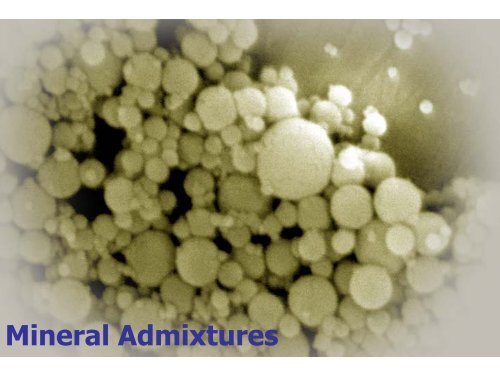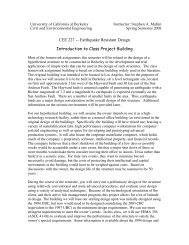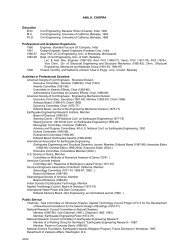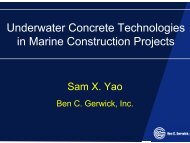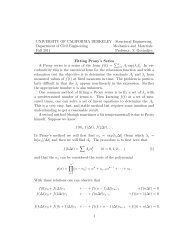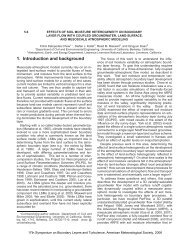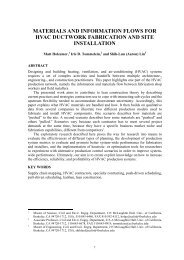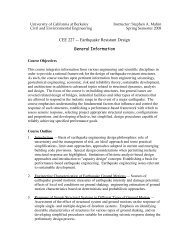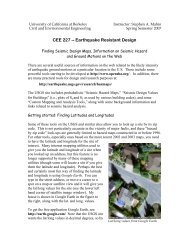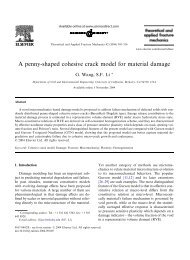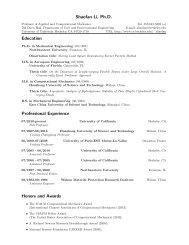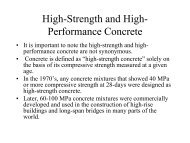Mineral Admixtures - Civil and Environmental Engineering
Mineral Admixtures - Civil and Environmental Engineering
Mineral Admixtures - Civil and Environmental Engineering
You also want an ePaper? Increase the reach of your titles
YUMPU automatically turns print PDFs into web optimized ePapers that Google loves.
<strong>Mineral</strong> <strong>Admixtures</strong>
<strong>Mineral</strong> <strong>Admixtures</strong><br />
The Pantheon, called the<br />
Temple of the Gods, is one of<br />
the greatest engineering<br />
wonders of the Roman Empire.<br />
Built in 128 A.D. by Emperor<br />
Hadrian, the Pantheon held the<br />
world record for the largest<br />
dome diameter (43.2m) for<br />
almost 1800 years.<br />
P.K. Mehta <strong>and</strong> P.J.M. Monteiro, Concrete: Microstructure, Properties, <strong>and</strong> Materials
<strong>Mineral</strong> <strong>Admixtures</strong><br />
Archimedes, one of the greatest Greek engineers,<br />
refused to write a textbook on engineering because the<br />
work of an engineer <strong>and</strong>, indeed, everything that would<br />
in any way make life easier, was ignoble <strong>and</strong> vulgar<br />
P.K. Mehta <strong>and</strong> P.J.M. Monteiro, Concrete: Microstructure, Properties, <strong>and</strong> Materials
<strong>Mineral</strong> <strong>Admixtures</strong><br />
<strong>Mineral</strong> <strong>Admixtures</strong><br />
• <strong>Mineral</strong> admixtures are finely divided siliceous materials which<br />
are added to concrete in relatively large amounts, generally in<br />
the range 20 to 70 percent by mass of the total cementitious<br />
material.<br />
P.K. Mehta <strong>and</strong> P.J.M. Monteiro, Concrete: Microstructure, Properties, <strong>and</strong> Materials
<strong>Mineral</strong> <strong>Admixtures</strong><br />
Ecological Advantage<br />
• Power plants using coal as fuel <strong>and</strong> metallurgical<br />
furnaces producing cast iron, silicon metal, <strong>and</strong><br />
ferrosilicon alloys are the major sources of byproducts<br />
that are being produced at the rate of<br />
millions of tonnes every year in many countries.<br />
• Dumping of these by-products into l<strong>and</strong>fills <strong>and</strong><br />
streams amounts to a waste of the material <strong>and</strong><br />
causes serious environmental pollution.<br />
P.K. Mehta <strong>and</strong> P.J.M. Monteiro, Concrete: Microstructure, Properties, <strong>and</strong> Materials
<strong>Mineral</strong> <strong>Admixtures</strong><br />
Ecological Impact<br />
• Disposal as concrete aggregate or for roadbase<br />
construction is a low-value use which does not<br />
utilize the pozzolanic <strong>and</strong> cementitious potential of<br />
those materials.<br />
• With proper quality control, large amounts of<br />
many industrial by-products can be incorporated<br />
into concrete, either in the form of blended<br />
portl<strong>and</strong> cement or as mineral admixtures.<br />
P.K. Mehta <strong>and</strong> P.J.M. Monteiro, Concrete: Microstructure, Properties, <strong>and</strong> Materials
<strong>Mineral</strong> <strong>Admixtures</strong><br />
Ecology<br />
• Whenever a pozzolanic <strong>and</strong>/or cementitious<br />
byproduct can be used as a partial replacement for<br />
portl<strong>and</strong> cement in concrete, it represents<br />
significant energy <strong>and</strong> cost savings.<br />
P.K. Mehta <strong>and</strong> P.J.M. Monteiro, Concrete: Microstructure, Properties, <strong>and</strong> Materials
<strong>Mineral</strong> <strong>Admixtures</strong><br />
Pozzolanic Reaction<br />
• silica + CH ---> C-S-H<br />
• The mechanism by which pozzolanic reaction<br />
exercises a beneficial effect on the properties of<br />
concrete is the same irrespective of whether a<br />
pozzolanic material is added to concrete in the<br />
form of a mineral admixture or as a component of<br />
blended portl<strong>and</strong> cement.<br />
P.K. Mehta <strong>and</strong> P.J.M. Monteiro, Concrete: Microstructure, Properties, <strong>and</strong> Materials
<strong>Mineral</strong> <strong>Admixtures</strong><br />
Different Performances<br />
• pozzolanic (e.g., low-calcium fly ash),<br />
• cementitious (e.g., granulated iron blast-furnace<br />
slag),<br />
• both cementitious <strong>and</strong> pozzolanic (e.g., highcalcium<br />
fly ash)<br />
P.K. Mehta <strong>and</strong> P.J.M. Monteiro, Concrete: Microstructure, Properties, <strong>and</strong> Materials
<strong>Mineral</strong> <strong>Admixtures</strong><br />
Classification<br />
• Natural materials: have been processed for the<br />
sole purpose of producing a pozzolan. Processing<br />
usually involves crushing, grinding, <strong>and</strong> size<br />
separation; in some cases it may also involve<br />
thermal activation.<br />
• By-product materials: are not the primary products<br />
of the industry producing them. Industrial byproducts<br />
may or may not require any processing.<br />
P.K. Mehta <strong>and</strong> P.J.M. Monteiro, Concrete: Microstructure, Properties, <strong>and</strong> Materials
<strong>Mineral</strong> <strong>Admixtures</strong><br />
Natural Pozzolans<br />
• Except diatomaceous earth, all natural pozzolans<br />
are derived from volcanic rocks <strong>and</strong> minerals.<br />
• During explosive volcanic eruptions quick cooling<br />
of the magma, which is composed mainly of<br />
aluminosilicates results in the formation of glass or<br />
vitreous phases with disordered structure.<br />
P.K. Mehta <strong>and</strong> P.J.M. Monteiro, Concrete: Microstructure, Properties, <strong>and</strong> Materials
<strong>Mineral</strong> <strong>Admixtures</strong><br />
Natural Pozzolans: Classification (1)<br />
• Volcanic glasses: Santorini Earth of Greece,<br />
Bacoli Pozzolan of Italy, <strong>and</strong> Shirasu Pozzolan of<br />
Japan are examples of pozzolanic materials which<br />
derive their lime-reactivity characteristic mainly<br />
from the unaltered aluminosilicate glass.<br />
• Volcanic tuffs: Pozzolans of Segni-Latium (Italy),<br />
<strong>and</strong> trass of Rheinl<strong>and</strong> <strong>and</strong> Bavaria (Germany),<br />
represent typical volcanic tuffs.<br />
P.K. Mehta <strong>and</strong> P.J.M. Monteiro, Concrete: Microstructure, Properties, <strong>and</strong> Materials
<strong>Mineral</strong> <strong>Admixtures</strong><br />
Natural Pozzolans: Classification (2)<br />
• Calcined clays or shales: clay <strong>and</strong> shales will<br />
not show appreciable reactivity with lime unless<br />
the crystal structures of the clay minerals present<br />
are destroyed by heat treatment.<br />
• Temperatures on the order of 600 to 900 C, in<br />
kilns is required for this purpose.<br />
• The pozzolanic activity of the product is due<br />
mainly to the formation of an amorphous or<br />
disordered aluminosilicate structure as a result of<br />
the thermal treatment.<br />
P.K. Mehta <strong>and</strong> P.J.M. Monteiro, Concrete: Microstructure, Properties, <strong>and</strong> Materials
<strong>Mineral</strong> <strong>Admixtures</strong><br />
Natural Pozzolans: Classification (3)<br />
• Diatomaceous earth: This group of pozzolans is<br />
characterized by materials of organic origin.<br />
• Diatomite is a hydrated amorphous silica which is<br />
composed of skeletal shells from the cell walls of<br />
many varieties of microscopic aquatic algae. The<br />
largest known deposit is in California.<br />
P.K. Mehta <strong>and</strong> P.J.M. Monteiro, Concrete: Microstructure, Properties, <strong>and</strong> Materials
<strong>Mineral</strong> <strong>Admixtures</strong><br />
By-Product Materials<br />
• Ashes from the combustion of coal <strong>and</strong> some crop<br />
residues such as rice hull <strong>and</strong> rice straw, silica<br />
fume from certain metallurgical operations, <strong>and</strong><br />
granulated slag from both ferrous <strong>and</strong> nonferrous<br />
metal industries are the major industrial byproducts<br />
that are suitable for use as mineral<br />
admixtures in portl<strong>and</strong> cement concrete.<br />
P.K. Mehta <strong>and</strong> P.J.M. Monteiro, Concrete: Microstructure, Properties, <strong>and</strong> Materials
<strong>Mineral</strong> <strong>Admixtures</strong><br />
Significance<br />
• Countries like China, India, the United States,<br />
Russia, Germany, South Africa, <strong>and</strong> the United<br />
Kingdom, are among the biggest producers of fly<br />
ash which, at the current (Year 2000) rate of<br />
production, some 500 million tonnes a year<br />
constitutes the largest industrial waste product in<br />
the world.<br />
P.K. Mehta <strong>and</strong> P.J.M. Monteiro, Concrete: Microstructure, Properties, <strong>and</strong> Materials
<strong>Mineral</strong> <strong>Admixtures</strong><br />
Fly ash<br />
• During the combustion of coal in power plants the<br />
volatile matter <strong>and</strong> carbon are burned off while<br />
most of the mineral impurities such as clays,<br />
quartz, <strong>and</strong> feldspar, melt at the high temperature.<br />
• The fused matter is quickly transported to lowertemperature<br />
zones where it solidifies as spherical<br />
particles of glass. Some of the minerals<br />
agglomerate forming the bottom ash, but most of<br />
the fine particles fly out with the flue gas stream<br />
<strong>and</strong> are called fly ash<br />
P.K. Mehta <strong>and</strong> P.J.M. Monteiro, Concrete: Microstructure, Properties, <strong>and</strong> Materials
<strong>Mineral</strong> <strong>Admixtures</strong><br />
Classification<br />
• Fly ashes can be divided into two categories which<br />
differ from each other mainly in calcium content.<br />
• The ash containing less than 10 percent CaO, is<br />
generally a product of the combustion of<br />
anthracite <strong>and</strong> bituminous coals.<br />
• The ash typically containing 15 to 35 percent<br />
analytical CaO, is generally a product of<br />
combustion of lignite <strong>and</strong> subbituminous coals.<br />
P.K. Mehta <strong>and</strong> P.J.M. Monteiro, Concrete: Microstructure, Properties, <strong>and</strong> Materials
<strong>Mineral</strong> <strong>Admixtures</strong><br />
Low-calcium fly ashes<br />
• Due to the high proportions of silica <strong>and</strong> alumina<br />
present, consist principally of aluminosilicate glass.<br />
• The partial devitrification of glass in low-lime fly<br />
ashes accounts for the presence of crystalline<br />
aluminosilicates.<br />
• Since these crystalline minerals are nonreactive at<br />
ordinary temperature, their presence in large<br />
proportions, at the cost of the noncrystalline<br />
component or glass, tends to reduce the reactivity<br />
of the fly ash.<br />
P.K. Mehta <strong>and</strong> P.J.M. Monteiro, Concrete: Microstructure, Properties, <strong>and</strong> Materials
<strong>Mineral</strong> <strong>Admixtures</strong><br />
High-calcium fly ash<br />
• It is more reactive because it contains most of the<br />
calcium in the form of reactive crystalline<br />
compounds.<br />
• More than 5 percent carbon in a fly ash that is<br />
meant for use as a mineral admixture in concrete<br />
is considered undesirable because the cellular<br />
particles of carbon tend to increase both the water<br />
requirement for a given consistency <strong>and</strong> the<br />
admixture requirement for air entrainment.<br />
P.K. Mehta <strong>and</strong> P.J.M. Monteiro, Concrete: Microstructure, Properties, <strong>and</strong> Materials
<strong>Mineral</strong> <strong>Admixtures</strong><br />
Microstructure<br />
• Most of the particles in fly ash occur as solid<br />
spheres of glass.<br />
• Typically, the spherical particles in low-calcium fly<br />
ashes look cleaner than those in high-calcium fly<br />
ashes. As alkalies <strong>and</strong> sulfate tend to occur in a<br />
relatively larger proportion in the high-calcium fly<br />
ashes, the deposition of alkali sulfates on the<br />
surface of spherical particles accounts for their<br />
dirty appearance of the spheres.<br />
P.K. Mehta <strong>and</strong> P.J.M. Monteiro, Concrete: Microstructure, Properties, <strong>and</strong> Materials
<strong>Mineral</strong> <strong>Admixtures</strong><br />
Particle size<br />
• Particle size distribution studies show that the<br />
particles in a typical fly ash vary from 1 to 100<br />
micra in diameter, with more than 50 percent<br />
under 20 micra.<br />
• The particle size distribution, morphology, <strong>and</strong><br />
surface characteristics of the fly ash selected for<br />
use as a mineral admixture exercise a considerable<br />
influence on the water requirement <strong>and</strong> the<br />
workability of fresh concrete, <strong>and</strong> the rate of<br />
strength development in hardened concrete.<br />
P.K. Mehta <strong>and</strong> P.J.M. Monteiro, Concrete: Microstructure, Properties, <strong>and</strong> Materials
<strong>Mineral</strong> <strong>Admixtures</strong><br />
Iron Blast-furnace slag<br />
• In the production of cast iron (also called pig iron)<br />
if the liquid slag is rapidly quenched from a high<br />
temperature by either water or a combination of<br />
air <strong>and</strong> water, most of the lime, magnesia, silica,<br />
<strong>and</strong> alumina are held in a noncrystalline or glassy<br />
state.<br />
• The water-quenched product is called granulated<br />
slag due to s<strong>and</strong>-size particles.<br />
P.K. Mehta <strong>and</strong> P.J.M. Monteiro, Concrete: Microstructure, Properties, <strong>and</strong> Materials
<strong>Mineral</strong> <strong>Admixtures</strong><br />
Strength Contribution<br />
• Compared to low-calcium fly ash, which usually<br />
does not make any significant contribution to the<br />
strength of portl<strong>and</strong> cement concrete until after<br />
about two weeks of hydration, significant strength<br />
contribution by high-calcium fly ash or granulated<br />
iron blast-furnace slag generally occurs as early as<br />
7 days after hydration.<br />
P.K. Mehta <strong>and</strong> P.J.M. Monteiro, Concrete: Microstructure, Properties, <strong>and</strong> Materials
<strong>Mineral</strong> <strong>Admixtures</strong><br />
Silica fume<br />
• is by-product of the induction arc furnaces in the<br />
silicon metal <strong>and</strong> ferrosilicon alloy industries.<br />
Reduction of quartz to silicon at temperatures up<br />
to 2000 C produces SiO vapors, which oxidize <strong>and</strong><br />
condense in the low-temperature zone to tiny<br />
spherical particles consisting of noncrystalline<br />
silica.<br />
P.K. Mehta <strong>and</strong> P.J.M. Monteiro, Concrete: Microstructure, Properties, <strong>and</strong> Materials
<strong>Mineral</strong> <strong>Admixtures</strong><br />
Particle size distribution<br />
• Compared to normal portl<strong>and</strong> cement <strong>and</strong> typical<br />
fly ashes, silica fume samples show particle size<br />
distributions that are two orders of magnitude<br />
finer.<br />
P.K. Mehta <strong>and</strong> P.J.M. Monteiro, Concrete: Microstructure, Properties, <strong>and</strong> Materials
<strong>Mineral</strong> <strong>Admixtures</strong><br />
Silica Fume Particles<br />
P.K. Mehta <strong>and</strong> P.J.M. Monteiro, Concrete: Microstructure, Properties, <strong>and</strong> Materials
<strong>Mineral</strong> <strong>Admixtures</strong><br />
Rice husk ash<br />
• Rice husks, also called rice hulls, are the shells<br />
produced during the dehusking operation of paddy<br />
rice. As they are bulky, the husks present an<br />
enormous disposal problem for centralized rice<br />
mills.<br />
• Each tonne of paddy rice produces about 200 kg<br />
of husk, which on combustion yield approximately<br />
40 kg of ash.<br />
P.K. Mehta <strong>and</strong> P.J.M. Monteiro, Concrete: Microstructure, Properties, <strong>and</strong> Materials
<strong>Mineral</strong> <strong>Admixtures</strong><br />
Rice husk ash: production<br />
• The ash formed during open-field burning or<br />
uncontrolled combustion in furnaces generally<br />
contains a large proportion of less reactive silica<br />
minerals such as cristobalite <strong>and</strong> tridymite, <strong>and</strong><br />
must be ground to a very fine particle size in order<br />
to develop some pozzolanic activity.<br />
• A highly pozzolanic ash can be produced by<br />
controlled combustion when silica is retained in<br />
noncrystalline form <strong>and</strong> a cellular microstructure<br />
P.K. Mehta <strong>and</strong> P.J.M. Monteiro, Concrete: Microstructure, Properties, <strong>and</strong> Materials
<strong>Mineral</strong> <strong>Admixtures</strong><br />
Metakaolin<br />
• High-purity kaolinitic clays can be calcined at<br />
relatively low temperature 600-700 C to keep silica<br />
<strong>and</strong> alumina in amorphous state, then pulverized<br />
to particles smaller than 2 microns. The product is<br />
a highly reactive pozzolan of white color that is<br />
especially suitable for use in architectural concrete.<br />
P.K. Mehta <strong>and</strong> P.J.M. Monteiro, Concrete: Microstructure, Properties, <strong>and</strong> Materials
<strong>Mineral</strong> <strong>Admixtures</strong><br />
Mechanisms of Action<br />
• Control of Bleeding: Channels of bleeding water are obstructed<br />
by the small particles.<br />
• Grain Refinement: without pozzolans large CH crystals develop<br />
• Pore Refinement: reduction of porosity<br />
P.K. Mehta <strong>and</strong> P.J.M. Monteiro, Concrete: Microstructure, Properties, <strong>and</strong> Materials
<strong>Mineral</strong> <strong>Admixtures</strong><br />
Workability improvement<br />
• With fresh concrete mixtures that show a tendency<br />
to bleed or segregate, the incorporation of finely<br />
divided particles generally improves the workability<br />
by reducing the size <strong>and</strong> volume of voids.<br />
• The finer a mineral admixture, the less will be the<br />
amount needed for enhancement of the<br />
cohesiveness <strong>and</strong> workability of freshly-mixed<br />
concrete.<br />
• The small size <strong>and</strong> the glassy texture of fly ash<br />
<strong>and</strong> slag makes it possible to reduce the amount<br />
of water required for a given consistency.<br />
P.K. Mehta <strong>and</strong> P.J.M. Monteiro, Concrete: Microstructure, Properties, <strong>and</strong> Materials
<strong>Mineral</strong> <strong>Admixtures</strong><br />
Workability<br />
• All mineral admixtures tend to improve the<br />
cohesiveness <strong>and</strong> workability of fresh concrete,<br />
but many do not possess the water-reducing<br />
capability of fly ash <strong>and</strong> slag.<br />
• For a given consistency of concrete, the use of<br />
very high surface area materials, such as pumicite,<br />
rich husk ash, <strong>and</strong> silica fume increases the water<br />
requirement.<br />
P.K. Mehta <strong>and</strong> P.J.M. Monteiro, Concrete: Microstructure, Properties, <strong>and</strong> Materials
<strong>Mineral</strong> <strong>Admixtures</strong><br />
Durability to thermal cracking<br />
• <strong>Mineral</strong> admixtures reduces the temperature rise<br />
almost in direct proportion to the amount of<br />
portl<strong>and</strong> cement replaced by the admixture.<br />
• These admixtures do not react to a significant<br />
degree for several days.<br />
• As a rule of thumb, the total heat of hydration<br />
produced by the pozzolanic reactions involving<br />
mineral admixtures is considered to be half as<br />
much as the average heat produced by the<br />
hydration of portl<strong>and</strong> cement.<br />
P.K. Mehta <strong>and</strong> P.J.M. Monteiro, Concrete: Microstructure, Properties, <strong>and</strong> Materials
<strong>Mineral</strong> <strong>Admixtures</strong><br />
Durability to chemical attack<br />
• The permeability of concrete plays a fundamental<br />
role in determining the rate of deterioration due to<br />
destructive chemical actions such as the alkaliaggregate<br />
expansion <strong>and</strong> attack by acidic or<br />
sulfate solution.<br />
• The pozzolanic reaction involving mineral<br />
admixtures causes pore refinement which reduces<br />
the permeability of concrete, studies have shown<br />
considerable improvement in the chemical<br />
durability of concrete containing mineral<br />
admixtures.<br />
P.K. Mehta <strong>and</strong> P.J.M. Monteiro, Concrete: Microstructure, Properties, <strong>and</strong> Materials
<strong>Mineral</strong> <strong>Admixtures</strong><br />
Durability<br />
• <strong>Mineral</strong> admixtures improves the resistance of the<br />
concrete to acidic water, sulfate water, <strong>and</strong><br />
seawater.<br />
• This is due to the pozzolanic reaction, which is<br />
accompanied by a reduction in permeability as well<br />
as a reduction in the calcium hydroxide content of<br />
the hydrated product.<br />
P.K. Mehta <strong>and</strong> P.J.M. Monteiro, Concrete: Microstructure, Properties, <strong>and</strong> Materials
<strong>Mineral</strong> <strong>Admixtures</strong><br />
Summary: Advantages<br />
• Removal of CH<br />
• Densification<br />
• Improve Durability<br />
• Reduce Thermal Cracking<br />
• Improve workability <strong>and</strong> cohesiveness<br />
• Reduce bleeding <strong>and</strong> segregation<br />
• Increase ultimate strength<br />
P.K. Mehta <strong>and</strong> P.J.M. Monteiro, Concrete: Microstructure, Properties, <strong>and</strong> Materials


